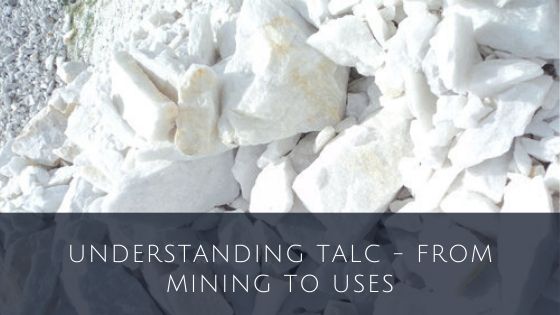Most people are familiar with the mineral talc. A naturally occurring mineral, talc is a hydrous magnesium silicate mineral (Mg3Si4O10(OH)2) composed of magnesium, silicon, hydrogen and oxygen. Mined from Earth, this “secret ingredient” is odourless, colourless and imperceptible. And because of its properties, it is highly effective for so many applications.
What is Talc?
Talc is the softest known mineral with a pearly lustre. It can be green, white, grey, brown, or colourless. It is a monoclinic mineral with a sheet structure having perfect cleavage that follows planes between the weakly bonded sheets. These sheets are held together by Van der Waals bonds allowing them to slip past one another. This gives the mineral an extremely soft, greasy and soapy feel.
The most common form of talc is seen as talcum powder where the mineral is crushed into the form of white powder. This powder has the ability to absorb moisture, oil, odours, serve as a lubricant, and produce an astringent effect on human skin. All these properties make talc an important ingredient in baby powders, foot powders, first aid powders, and a variety of cosmetics application.
Soapstone is another widely known form of talc. This soft rock can be easily carved to make sculptures, bowls, countertops, sinks, hearths, pipe bowls, and many other ornamental and practical objects.
Moreover, the talc suppliers in India say that talc’s unique properties make it an important ingredient for making ceramics, paint, paper, roofing materials, plastics, rubber, insecticides, and many other products.
Uses of Talc
Talc is an important ingredient in rubber manufacturing, paint, paper industry, and also a primary ingredient in various cosmetics. Most people use products made from talc every day; however, they don’t realize that talc is in the product or the special role that it plays.
Some of the common uses of talc are:
- Cosmetics and Antiperspirants
- Roofing Materials
- Pulp and Paper
- Paints and Coatings
- Plastic and Rubber
- Cordierite Ceramics
- Polyester Putties
- Food
- Personal Care
- Pharmaceuticals
Talc for Plastics
Talc is used as a filler in plastic. Talc particles have a platy shape that increases the stiffness of products like polypropylene, vinyl, polyethene, nylon, and polyester. It also reduces shrinkage and increases its heat resisting power.
Talc for Ceramics
Talc is used in the manufacturing of ceramics products such as bathroom fixtures, ceramic tile, pottery, and dinnerware. Talc improves the firing characteristics and strengthens the finished product. Therefore, it is used as a filler in ceramic manufacturing.
Talc for Paint
Talc has a unique sheen which serves to whiten and brighten the paint. Paints are made from suspensions of mineral particles in a liquid. Where the liquid portion facilitates the application process and once it evaporates, the mineral particles remain on the wall. Talc is used as an extender and filler in paints. Moreover, the softness of talc reduces abrasion damage on spray nozzles and other equipment when the paint is applied.
Talc for Paper
Here again, talk mineral serves as a filler. Paper is made of pulp from organic fibres like wood, rags, and other organic materials. The talc fills spaces between the pulp fibres when rolled into thin sheets, resulting in a paper with a much smoother writing surface. Talc also improves opacity, brightness, and whiteness of the paper and its ability to absorb ink.
Talc for Cosmetics and Antiperspirants
The smooth and fine property of talc is used as a base in many cosmetic products. The tiny platelets of the mineral powder get attached to the skin quickly and can also be washed off easily without causing skin abrasion.
As mentioned earlier, the mineral also has the ability to absorb oils and perspiration produced by human skin.
Talc for Roofing Materials
Talc property can be used to improve its resistance to the weather. Therefore, it is added to the asphaltic materials that are used to make roofing materials. When dusted on the surface of roll roofing and shingles, it prevents sticking.
Other Uses of Talc
Finely grounded talc is used as a lubricant in many applications involving high temperatures. It has a tendency to survive in high temperature where other oil-based lubricants might get destroyed. The mineral is also used as a carrier for insecticides and fungicides. It can easily be blown through a nozzle and readily sticks to the leaves and stems of plants.
How Does Talc Form?
Talc mining in India is done at a few selected locations. Talc is found in metamorphic rocks of convergent plate boundaries. It is formed from two processes.
- Heated water carrying dissolved magnesium and silica reacts with dolomitic marbles.
- Heat and active fluids alter dunite and serpentinite like rocks into talc.
Talc Mining and Processing
Talc mines in India are open-pit mines. According to the talc miners, rocks are drilled, blasted, and partially crushed in the mining operation. These rocks are then taken to a mill, where they are further grounded finely to meets customer requirements for particle size, brightness, composition, and other properties.

